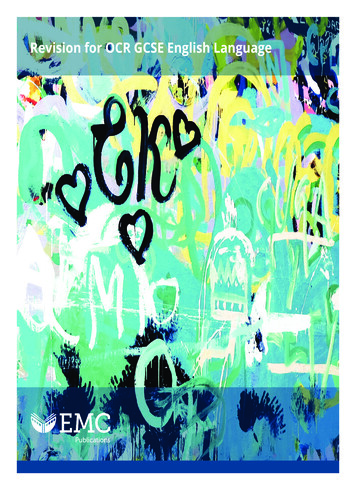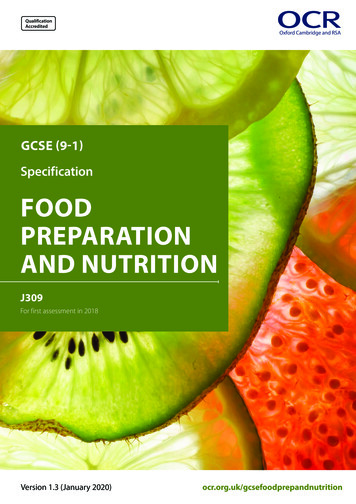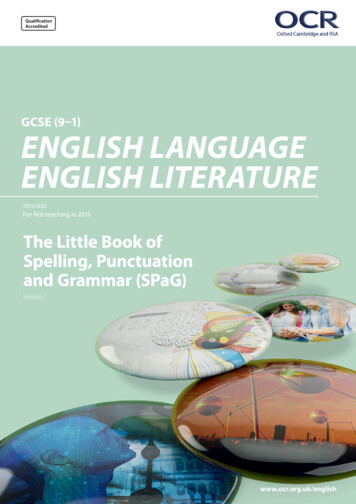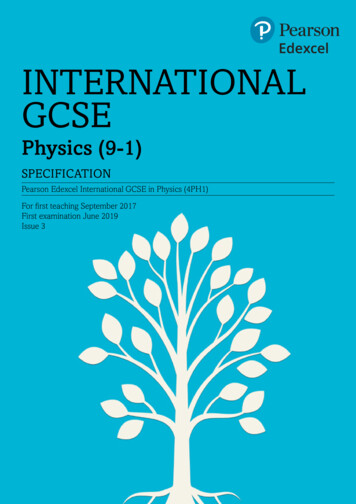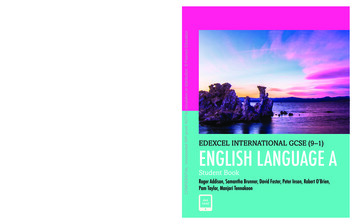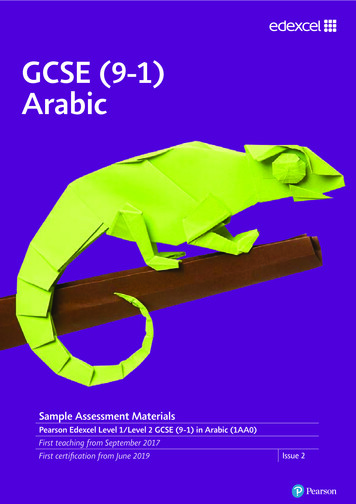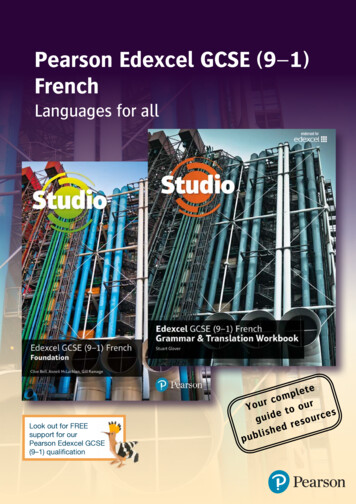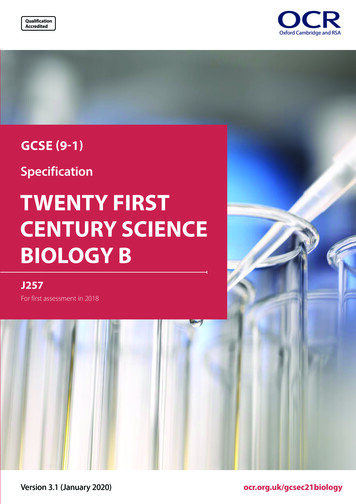
Transcription
QualificationAccreditedOxford Cambridge and RSAGCSE (9-1)SpecificationTWENTY FIRSTCENTURY SCIENCEBIOLOGY BJ257For first assessment in 2018Version 3.1 (January 2020)ocr.org.uk/gcsec21biology
DisclaimerRegistered office: The Triangle BuildingShaftesbury RoadCambridgeCB2 8EAOCR is an exempt charity.Specifications are updated over time. Whilst every effort is made to check alldocuments, there may be contradictions between published resources and thespecification, therefore please use the information on the latest specification atall times. Where changes are made to specifications these will be indicated withinthe document, there will be a new version number indicated, and a summaryof the changes. If you do notice a discrepancy between the specification and aresource please contact us at: resources.feedback@ocr.org.ukWe will inform centres about changes to specifications. We will also publishchanges on our website. The latest version of our specifications will always bethose on our website (ocr.org.uk) and these may differ from printed versions. 2021 OCR. All rights reserved.CopyrightOCR retains the copyright on all its publications, including the specifications.However, registered centres for OCR are permitted to copy material from thisspecification booklet for their own internal use.Oxford Cambridge and RSA is a Company Limited by Guarantee. Registered inEngland. Registered company number 3484466.
ContentsSupport and Guidance Assessment Preparation and Analysis Service 12345iiiiiWhy choose an OCR GCSE (9–1) in Biology B (Twenty First Century Science)? 11a.1b.1c.1d.Why choose an OCR qualification? Why choose an OCR GCSE (9–1) in Biology B (Twenty First Century Science)? What are the key features of this specification? How do I find out more information? 1244The specification overview 52a.2b.2c.OCR’s GCSE (9–1) in Biology B (Twenty First Century Science) (J257) Content of GCSE (9–1) in Biology B (Twenty First Century Science) (J257) Content of chapters B1 to B8 569Assessment of GCSE (9–1) in Biology B (Twenty First Century Science) 613a.3b.3c.3d.3e.3f.3g.3h.3i.Forms of assessment Assessment objectives (AO) Command words Tiers Assessment availability Retaking the qualification Assessment of extended response Synoptic assessment Calculating qualification results 616263656566666666Admin: what you need to know 674a.4b.4c.4d.4e.4f.Pre-assessment Special consideration External assessment arrangements Results and certificates Post-results services Malpractice 676768696969Appendices 705a.5b.5c.5d.5e.5f.5g.Grade descriptors Overlap with other qualifications Accessibility Units in science Mathematical skills Mathematical skills requirement Health and Safety 70717172737476Summary of updates 77 OCR 2021GCSE (9–1) in Biology B (Twenty First Century Science)i
Support and GuidanceIntroducing a new specification brings challenges forimplementation and teaching, but it also opens upnew opportunities. Our aim is to help you at everystage. We are working hard with teachers and otherexperts to bring you a package of practical support,resources and training.Subject AdvisorsOCR Subject Advisors provide information andsupport to centres including specification and nonexam assessment advice, updates on resourcedevelopments and a range of training opportunities.Our Subject Advisors work with subject communitiesthrough a range of networks to ensure the sharing ofideas and expertise supporting teachers and studentsalike. They work with developers to help produce ourspecifications and the resources needed to supportthese qualifications during their development.You can contact our Science Subject Advisors forspecialist advice, guidance and support:01223 553998ScienceGCSE@ocr.org.uk@OCR ScienceTeaching and learning resourcesOur resources are designed to provide you with arange of teaching activities and suggestions thatenable you to select the best activity, approach orcontext to support your teaching style and yourparticular students. The resources are a body ofiiknowledge that will grow throughout the lifetime ofthe specification, they include: Delivery GuidesTransition GuidesTopic Exploration PacksLesson Elements.We also work with a number of leading publisherswho publish textbooks and resources for ourspecifications. For more information on ourpublishing partners and their resources eform/publishing-partnersProfessional developmentOur improved Professional DevelopmentProgramme fulfils a range of needs throughcourse selection, preparation for teaching, deliveryand assessment. Whether you want to come toface-to-face events, look at our new digital trainingor search for training materials, you can find whatyou’re looking for all in one place at the CPD Hub:cpdhub.ocr.org.ukAn introduction to new specificationsWe run training events throughout the academicyear that are designed to help prepare you for firstteaching and support every stage of your delivery ofthe new qualifications.To receive the latest information about the trainingwe offer on GCSE and A Level, please register foremail updates at: ocr.org.uk/updates OCR 2021GCSE (9–1) in Biology B (Twenty First Century Science)
Assessment Preparation and Analysis ServiceAlong with subject-specific resources and tools, you’llalso have access to a selection of generic resourcesthat focus on skills development, professionalguidance for teachers and results data analysis.ExamBuilderEnabling you to build, mark and assess testsfrom OCR exam questions and produce acomplete mock GCSE or A Level exam.Find out more at ocr.org.uk/exambuilderSubject Advisor SupportOur Subject Advisors provideyou with access to specifications,high-quality teaching resourcesand assessment materials.Skills GuidesThese guides cover topics thatcould be relevant to a rangeof qualifications, for examplecommunication, legislationand research.Download the guides atocr.org.uk/skillsguides OCR 2021GCSE (9–1) in Biology B (Twenty First Century Science)Practice PapersAssess students’ progress underformal examination conditionswith question papers downloadedfrom a secure location, well-presented,easy-to-interpret mark schemesand commentary on marking andsample answers.Active ResultsOur free online results analysisservice helps you review theperformance of individual studentsor your whole cohort. For moredetails, please refer toocr.org.uk/activeresultsiii
iv OCR 2021GCSE (9–1) in Biology B (Twenty First Century Science)
1Why choose an OCR GCSE (9–1) in Biology B(Twenty First Century Science)?1a. Why choose an OCR qualification?Choose OCR and you’ve got the reassurance thatyou’re working with one of the UK’s leading examboards. Our new OCR GCSE (9–1) in Biology B(Twenty First Century Science) course has beendeveloped in consultation with teachers, employersand Higher Education to provide learners with aqualification that’s relevant to them and meetstheir needs.1We provide a range of support services designed tohelp you at every stage, from preparation throughto the delivery of our specifications. This includes: A wide range of high-quality creative resourcesincluding:Delivery GuidesTransition GuidesTopic Exploration PacksLesson Elements. . . and much more.⃝⃝⃝We’re part of the Cambridge Assessment Group,Europe’s largest assessment agency and adepartment of the University of Cambridge.Cambridge Assessment plays a leading role indeveloping and delivering assessments throughoutthe world, operating in over 150 countries.⃝⃝ Access to Subject Advisors to support youthrough the transition and throughout thelifetime of the specification.We work with a range of education providers,including schools, colleges, workplaces and otherinstitutions in both the public and private sectors.Over 13 000 centres choose our A Levels,GCSEs and vocational qualifications includingCambridge Nationals and Cambridge Technicals. CPD/Training for teachers to introduce thequalifications and prepare you for first teaching. Active Results – our free results analysisservice to help you review the performanceof individual learners or whole schools.Our Specifications ExamBuilder – our free online past papersservice that enables you to build your owntest papers from past OCR exam questions.We believe in developing specifications that help youbring the subject to life and inspire your learners toachieve more.We’ve created teacher-friendly specifications basedon extensive research and engagement with theteaching community. They’re designed to bestraightforward and accessible so that you can tailorthe delivery of the course to suit your needs. We aimto encourage learners to become responsible fortheir own learning, confident in discussing ideas,innovative and engaged. OCR 2021GCSE (9–1) in Biology B (Twenty First Century Science)All GCSE (9–1) qualifications offered by OCR areaccredited by Ofqual, the Regulator for qualificationsoffered in England. The accreditation number forOCR’s GCSE (9–1) in Biology B (Twenty First CenturyScience) is QN601/8506/5.1
1b. Why choose an OCR GCSE (9–1) in Biology B(Twenty First Century Science)?1We appreciate that one size doesn’t fit all so we offertwo suites of qualifications in each science:Biology A (Gateway Science) – Provides a flexibleapproach to teaching. The specification is divided intotopics, each covering different key concepts ofbiology. Teaching of practical skills is integrated withthe theoretical topics and they are assessed throughthe written papers.Biology B (Twenty First Century Science) – Learnersstudy biology using a narrative-based approach. Ideasare introduced within relevant and interesting settingswhich help learners to anchor their conceptualknowledge of the range of biological topics requiredat GCSE level. Practical skills are embedded withinthe specification and learners are expected to carryout practical work in preparation for a writtenexamination that will specifically test these skills.Biology B (Twenty First Century Science) has beendeveloped with the University of York ScienceEducation Group (UYSEG) in conjunction with subjectand teaching experts. Together we have aimed toproduce a specification with up to date relevantcontent accompanied by a narrative to give contextand an idea of the breadth of teaching required. Ournew GCSE (9–1) in Biology B (Twenty First CenturyScience) qualification builds on our existing popularcourse. We’ve based the redevelopment of our GCSE(9–1) sciences on an understanding of what workswell in centres large and small. We’ve undertakena significant amount of consultation through ourscience forums (which include representatives fromlearned societies, HE, teaching and industry) andthrough focus groups with teachers.The content is clear and logically laid out for bothexisting centres and those new to OCR, withassessment models that are straightforward toadminister. We have worked closely with teachersto provide high quality support materials to guideyou through the new qualifications.Aims and learning outcomesGCSE study in the sciences provides the foundationfor understanding the material world. Scientificunderstanding is changing our lives and is vital toworld’s future prosperity, and all learners should betaught essential aspects of the knowledge, methods,process and uses of science. They should be helped toappreciate how the complex and diverse phenomenaof the natural world can be described in terms of asmall number of key ideas relating to the scienceswhich are both inter-linked, and are of universalapplication. These key ideas include: 2the use of conceptual models and theories tomake sense of the observed diversity of naturalphenomena the assumption that every effect has one ormore cause that change is driven by differences betweendifferent objects and systems when theyinteract that many such interactions occur over adistance and over time without direct contact that science progresses through a cycle ofhypothesis, practical experimentation,observation, theory development and review that quantitative analysis is a central elementboth of many theories and of scientificmethods of inquiry. OCR 2021GCSE (9–1) in Biology B (Twenty First Century Science)
The Twenty First Century Science suite will enablelearners to: develop scientific knowledge and conceptualunderstanding through the specific disciplinesof biology, chemistry and physicsdevelop understanding of the nature, processesand methods of science, through differenttypes of scientific enquiries that help them toanswer scientific questions about the worldaround them OCR 2021GCSE (9–1) in Biology B (Twenty First Century Science) develop and learn to apply observational,practical, modelling, enquiry and problemsolving skills, both in the laboratory, in thefield and in other learning environments develop their ability to evaluate claims basedon science through critical analysis of themethodology, evidence and conclusions, bothqualitatively and quantitatively.13
1c.1What are the key features of this specification?Building on research, and on the principles of Beyond2000, the Twenty First Century Science suite wasoriginally developed by the University of York ScienceEducation Group (UYSEG), the Nuffield Foundationand OCR.The 2016 suite continues to recognise the diversityof interests and future intentions of the learnerpopulation who take a science qualification at GCSElevel. The specifications will prepare learners forprogression to further study of science, whilst at thesame time offering an engaging and satisfying coursefor those who choose not to study academic sciencefurther.cultural aspects of science that are of value andinterest to all develop learners’ abilities to evaluateknowledge claims critically, by looking at thenature, quality and extent of the evidence,and at the arguments that link evidence toconclusions develop learners’ understanding of theconcepts and models that scientists use toexplain natural phenomena develop learners’ ability to plan and carry outpractical investigations and their understandingof the role of experimental work in developingscientific explanations.The Twenty First Century Science suite will: take opportunities to link science to issuesrelevant to all learners as citizens, and to the1d. How do I find out more information?Whether new to our specifications, or continuingon from our legacy offerings, you can find moreinformation on our webpages at www.ocr.org.ukWant to find out more?Visit our subject pages to find out more about theassessment package and resources available tosupport your teaching. The science team alsorelease a termly newsletter Science Spotlight(despatched to centres and available from oursubject pages).Email: ScienceGCSE@ocr.org.uk,Telephone: 01223 553998If you are not already a registered OCR centre thenyou can find out more information on the benefits ofbecoming one at: www.ocr.org.ukYou can contact the Science Subject Advisors:Visit our Online Support Centre at support.ocr.org.ukCheck what CPD events are available:www.cpdhub.ocr.org.ukFollow us on Twitter:https://twitter.com/ocr scienceIf you are not yet an approved centre and would liketo become one go to: www.ocr.org.uk/approvals4 OCR 2021GCSE (9–1) in Biology B (Twenty First Century Science)
2The specification overview2a. OCR’s GCSE (9–1) in Biology B (Twenty First Century Science) (J257)Learners are entered for either Foundation Tier (components 01 and 02) or Higher Tier (components 03 and 04)to be awarded the OCR GCSE (9–1) in Biology B (Twenty First Century Science).Content OverviewAssessment Overview2Foundation Tier, grades 1 to 5Content is split into eight teaching chapters: Chapter B1: You and your genesChapter B2: Keeping healthyChapter B3: Living together – food andecosystemsChapter B4: Using food and controllinggrowthChapter B5: The human body – staying aliveChapter B6: Life on Earth – past, presentand futureChapter B7: Ideas about ScienceChapter B8: Practical SkillsBoth papers assess content from all eightchapters.Breadth in biologyJ257/0190 marks1 hour 45 minutesWritten paperDepth in biologyJ257/0290 marks1 hour 45 minutesWritten paper50%of totalGCSE50%of totalGCSEHigher Tier, grades 4 to 9Content is split into eight teaching chapters: Chapter B1: You and your genesChapter B2: Keeping healthyChapter B3: Living together – food andecosystemsChapter B4: Using food and controllinggrowthChapter B5: The human body – staying aliveChapter B6: Life on Earth – past, presentand futureChapter B7: Ideas about ScienceChapter B8: Practical SkillsBoth papers assess content from all eightchapters. OCR 2021GCSE (9–1) in Biology B (Twenty First Century Science)Breadth in biologyJ257/0390 marks1 hour 45 minutesWritten paperDepth in biologyJ257/0490 marks1 hour 45 minutesWritten paper50%of totalGCSE50%of totalGCSE5
2b. Content of GCSE (9–1) in Biology B (Twenty First Century Science) (J257)Layout of specification content23The specification content is divided into eightchapters. The first six chapters describe the sciencecontent to be taught and assessed. The seventhchapter describes the Ideas about Science thatshould be taught, and will be assessed in contextstaken from any of the preceding chapters. The Ideasabout Science cover the requirements of WorkingScientifically. The final chapter describes therequirements for practical skills.In the specification, the content that is assessable ispresented in two columns: the teaching and learningnarrative and the assessable learning outcomes.The narrative summarises the science story andprovides context for the assessable learningoutcomes thereby supporting the teaching of thespecification. The assessable learning outcomesdefine the requirements for assessment and anycontexts given in the narrative may also be assessed.Within each chapter:An overview summarises the science ideas included inthe chapter, explaining why these ideas are relevant tolearners living in the twenty first century and why it isdesirable for learners to understand them.Following the overview is a summary of the knowledgeand understanding that learners should have gainedfrom study at Key Stages 1 to 3. Some of these ideasare repeated in the content of the specification andwhile this material need not be retaught, it can bedrawn upon to develop ideas at GCSE (9–1).Learning at GCSE (9–1) is described in the tablesthat follow:Teaching and learningnarrativeAssessable learning outcomesLinked learningopportunitiesThe teaching and learningnarrative summarises thescience story, includingrelevant Ideas about Scienceto provide contexts for theassessable learning outcomes.The narrative is intended tosupport teaching and learning.The requirements forassessment are defined by theassessable learning outcomesand any contexts given in thenarrative may also beassessed.The assessable learning outcomesset out the level of knowledge andunderstanding that learners are expectedto demonstrate. The statements giveguidance on the breadth and depth oflearning.The linked learningopportunities suggest waysto develop Ideas aboutScience and practical skills incontext, and also highlightlinks to ideas in otherchapters.Emboldened statements will only beassessed in Higher Tier papers.The mathematical requirements inAppendix 5d are referenced by the prefixM to link the mathematical skills requiredto the areas of biology content wherethose mathematical skills could be linkedto learning.Note, however, that Ideasabout Science and practicalskills may be taught, andwill be assessed, in anycontext.Opportunities for carrying out practicalactivities are indicated throughout thespecification and are referenced as PAG1to PAG8 (Practical Activity Group, seeChapter 8).i Advisory notes clarify the depth ofcover required.6 OCR 2021GCSE (9–1) in Biology B (Twenty First Century Science)
The Assessment Objectives in Section 3b make clearthe range of ways in which learners will be requiredto demonstrate their knowledge and understandingin the assessments, and the Sample AssessmentMaterials (provided on the OCR website atwww.ocr.org.uk) provide examples.Biology key ideasBiology is the science of living organisms (includinganimals, plants, fungi and microorganisms) and theirinteractions with each other and the environment.The study of biology involves collecting andinterpreting information about the natural world toidentify patterns and relate possible cause and effect.Biological information is used to help humansimprove their own lives and strive to create asustainable world for future generations.the environment and with humans in manydifferent ways living organisms are interdependent and showadaptations to their environment Learners should be helped to understand how,through the ideas of biology, the complex and diversephenomena of the natural world can be described interms of a small number of key ideas which are ofuniversal application, and which include:life on Earth is dependent on photosynthesis inwhich green plants and algae trap light fromthe Sun to fix carbon dioxide and combine itwith hydrogen from water to make organiccompounds and oxygen organic compounds are used as fuels incellular respiration to allow the other chemicalreactions necessary for life life processes depend on molecules whosestructure is related to their function the chemicals in ecosystems are continuallycycling through the natural world the fundamental units of living organisms arecells, which may be part of highly adaptedstructures including tissues, organs and organsystems, enabling living processes to beperformed effectively the characteristics of a living organism areinfluenced by its genome and its interactionwith the environment evolution occurs by a process of naturalselection and accounts both for biodiversityand how organisms are all related to varyingdegrees. living organisms may form populations of singlespecies, communities of many species andecosystems, interacting with each other, with OCR 2021GCSE (9–1) in Biology B (Twenty First Century Science)27
28A summary of the content for the GCSE (9–1) Biology B (Twenty First Century Science) course is as follows:Chapter B1: You and your genesChapter B2: Keeping healthyB1.1 What is the genome and what does itdo?B1.2 How is genetic information inherited?B1.3 How can and should gene technology beused?B2.1 What are the causes of disease?B2.2 How do organisms protect themselves againstpathogens?B2.3 How can we prevent the spread of infections?B2.4 How can we identify the cause of an infection? (separatescience only)B2.5 How can lifestyle, genes and the environment affect myhealth?B2.6 How can we treat disease?Chapter B4: Using food andcontrolling growth OCR 2021GCSE (9–1) in Biology B (Twenty First Century Science)B4.1 What happens during cellularrespiration?B4.2 How do we know about mitochondriaand other cell structures?B4.3 How do organisms grow and develop?B4.4 How is plant growth controlled?(separate science only)B4.5 Should we use stem cells to treatdamage and disease?Chapter B5: The human body – staying aliveB5.1 How do substances get into, out of and around ourbodies?B5.2 How does the nervous system help us respond tochanges?B5.3 How do hormones control responses in the human body?B5.4 Why do we need to maintain a constant internalenvironment?B5.5 What role do hormones play in human reproduction?B5.6 What can happen when organs and control systems stopworking?Chapter B7: Ideas about ScienceIaS1IaS2IaS3IaS4What needs to be considered when investigating a phenomenon scientifically?What conclusions can we make from data?How are scientific explanations developed?How do science and technology impact society?Chapter B8: Practical SkillsChapter B3: Living together –food and ecosystemsB3.1 What happens during photosynthesis?B3.2 How do producers get the substancesthey need?B3.3 How are organisms in an ecosysteminterdependent?B3.4 How are populations affected byconditions in an ecosystem?Chapter B6: Life on Earth –past, present and futureB6.1 How was the theory of evolutiondeveloped?B6.2 How do sexual and asexual reproductionaffect evolution? (separate science only)B6.3 How does our understanding of biologyhelp us classify the diversity of organismson Earth?B6.4 How is biodiversity threatened and howcan we protect it?
2c.Content of chapters B1 to B8Chapter B1: You and your genesOverviewThe inheritance of genetic information from eachgeneration to the next is a fundamental idea inscience; it can help us answer questions about whywe look the way we do, and build a foundation forlater exploration of ideas about genetic diseases,cell division and growth, and evolution.Topic B1.1 explores basic concepts of the genomeand how it affects an organism’s characteristics,through ideas about DNA and genes as the units ofgenetic information, the link between genes andproteins, and how the interaction between genesand the environment affects how an individuallooks, develops and functions. Topic B1.2 exploresinheritance by considering the effects ofdominant and recessive alleles, the inheritanceof characteristics, the principles of inheritanceof single-gene characteristics and how sex isdetermined.2Understanding of the genome and emerging genetechnologies are at the cutting edge of science, andthey promise powerful applications to benefit presentand future generations. But they also present ethicalissues for individuals and society. Topic B1.3 exploressome of the ideas people use to make decisionsabout applications of gene technology includinggenetic testing and genetic engineering.Learning about genes and inheritance before GCSE (9–1)From study at Key Stages 1 to 3 learners should: know that living things produce offspring of thesame kind, but normally offspring vary and arenot identical to their parentsknow that heredity is the process by whichgenetic information is transmitted from onegeneration to the nextknow that genetic information is stored in thenucleus understand a simple model of chromosomes,genes and DNAknow about the part played by Watson, Crick,Wilkins and Franklin in the development of theDNA modelknow about sexual reproduction in animals,including the role of gametes and the processof fertilisationknow about sexual and asexual reproduction inplants, including flower structures and theprocesses of pollination and fertilisation.TieringStatements shown in bold type will only be tested inthe Higher Tier papers. OCR 2021GCSE (9–1) in Biology B (Twenty First Century Science)All other statements will be assessed in bothFoundation and Higher Tier papers.9
210Learning about genes and inheritance at GCSE (9–1)B1.1 What is the genome and what does it do?Teaching and learning narrativeAssessable learning outcomesLearners will be required to:Linked learningopportunitiesAll organisms contain genetic material. Genetic materialcontains instructions that control how cells and organismsdevelop and function. Most of an organism’s characteristicsdepend on these instructions and are modified by interactionwith the environment.1.a) e xplain how the nucleus and genetic material of eukaryoticcells (plants and animals) and the genetic material,including plasmids, of prokaryotic cells are related to cellfunctionsb) describe how to use a light microscope to observe a varietyof plant and animal cellsPAG1Practical work: use a microscopeto look at a varietyof plant andanimal cells extract DNA fromplant tissue2.describe the genome as the entire genetic material of anorganism3.describe DNA as a polymer made up of nucleotides, formingtwo strands in a double helix4.describe simply how the genome and its interaction with theenvironment influence the development of the phenotype ofan organism, including the idea that most characteristicsdepend on instructions in the genome and are modified byinteraction of the organism with its environmentSpecification links: principles ofpolymerisation,and DNA andproteins asexamples ofpolymers (C4.2)Genetic material in plant and animal cells is located in thenucleus, one of the main sub-cellular structures. In organismswhose cells do not have a nucleus (e.g. bacteria) the geneticmaterial is located in the cytoplasm.All the genetic material of a cell is the organism’s genome. Inmost organisms the genome is packaged into chromosomes.Chromosomes are long molecules of DNA. Genes are sectionsof this DNA. OCR 2021GCSE (9–1) in Biology B (Twenty First Century Science)In the cells of plants and animals, chromosomes occur in pairs.The two chromosomes in a pair each carry the same genes.The two versions of each gene in the pair are called alleles,and can be the same or different. A different version of a geneis a genetic variant. The genotype of an organism is thecombination of alleles it has for each gene; the phenotype isthe characteristic that results from this combination andinteraction with the environment. Genes tell a cell how tomake proteins by joining together amino acids in a particularorder.i Learners are not expected to describe epigenetic effects5.explain the terms chromosome, gene, allele, variant, genotypeand phenotype6.explain the importance of amino acids in the synthesis ofproteins, including the genome as instructions for thepolymerisation of amino acids to make proteins
OCR 2021GCSE (9–1) in Biology B (Twenty First Century Science)B1.1 What is the genome and what does it do?Teaching and learning narrativeAssessable learning outcomesLearners will be required to:Linked learningopportunitiesDNA is a polymer in which the monomers are nucleotides.Each nucleotide includes one of four different bases (adenine,thymine, cytosine or guanine).7.describe DNA as a polymer made from four differentnucleotides, each nucleotide consisting of a common sugar andphosphate group with one of four different bases attached tothe sugar(separate science only)Ideas about Science: using letters tomodel the geneticcode (IaS3)8.explain simply how the sequence of bases in DNA codes forthe prote
2a. OCR's GCSE (9-1) in Biology B (Twenty First Century Science) (J257) 5 2b. Content of GCSE (9-1) in Biology B (Twenty First Century Science) (J257) 6 2c. Content of chapters B1 to B8 9 3 Assessment of GCSE (9-1) in Biology B (Twenty First Century Science) 61 3a. Forms of assessment 61 3b. Assessment objectives (AO) 62 3c. Command .
